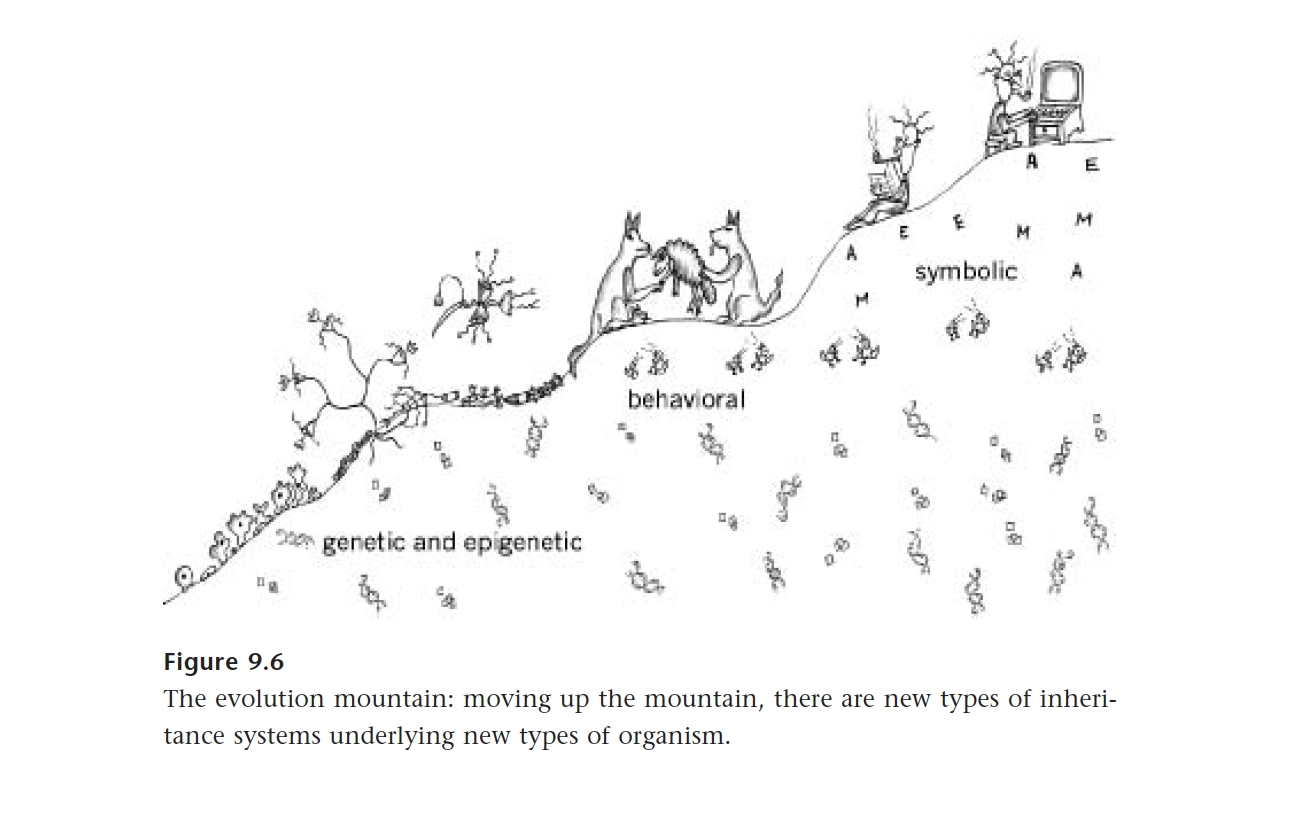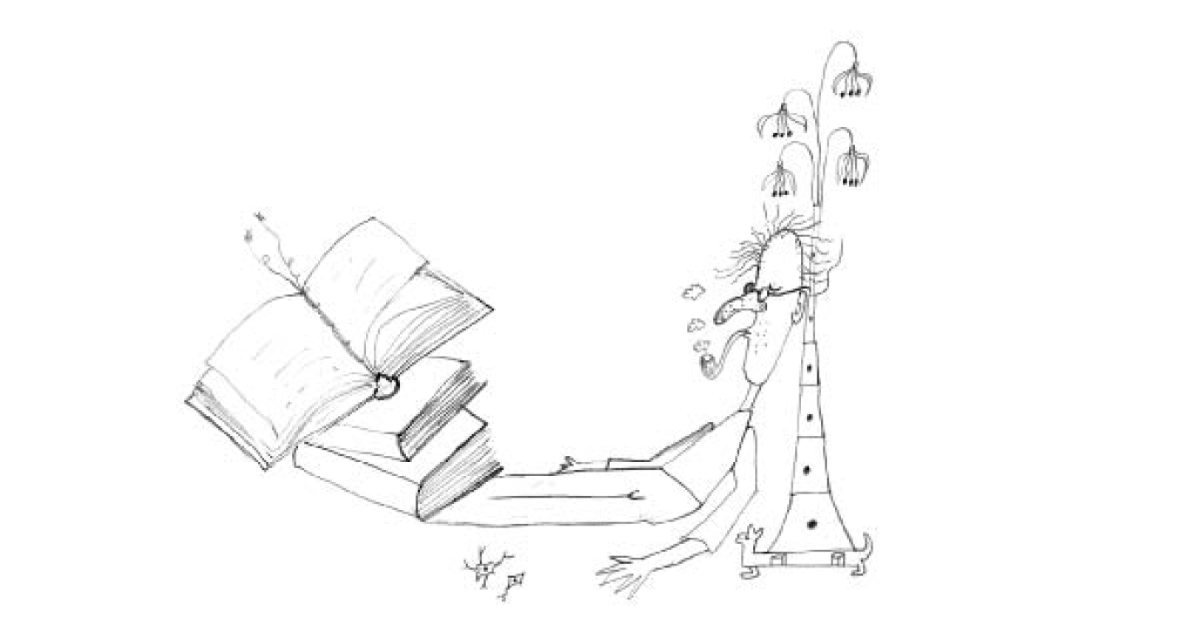Genes are seen as links to our ancient past, to our ancestors, which govern us in an irrational and mysterious manner. There is something very romantic in this notion—in the eternal dark and deep guiding force of the genes. And this peculiar combination of the romantic and the scientific is embodied in many of the human sociobiologists’ evolutionary stories.
It has been 165 years since Charles Darwin wrote of his contemplation of a tangled bank — clothed with plants of many kinds, birds singing on the bushes, with various insects flitting about, and worms crawling through the damp earth — and reflected on the origin of species, their evolution and complex interconnectedness. Theories of evolution have since come a long way, given the discovery of the Mendelian inheritance, the molecular basis of genetics and the completion of the human genome project. The premise of ‘Evolution in Four Dimensions’ is to challenge precisely the very dogmatic Darwinian theory of evolution that reduces heritability to mere natural selection of random genetic mutations. Orthodox Darwinism has always been philosophically puzzling: despite being a theory of how change comes about, it paradoxically emphasizes continuity, treating change (mutation) as a rare, incidental occurrence. In contrast, Eva Jablonka and Marion J. Lamb present a more dynamic perspective on evolution. They broaden the concept of inherited information beyond the genome to include knowledge acquired through cultural and behavioural means. Organisms, therefore, are not merely passive vehicles of fixed genetic data; they actively interact with, interpret, and contribute to the evolutionary process through the perpetuation of culture and behaviours that are then incorporated into the genome and epigenome. This fresh perspective reveals life to be far more complex and creative than biologists are able to explain.
Jablonka and Lamb sharply critique evolutionary biologists’ romanticism and tunnel vision towards genes being the sole evolutive, transmissible units. In stating that DNA is not the be-all and end-all of heredity, the authors usher in a new outlook for future research towards the theorisation of human behavior and socio-cultural evolution since the dawn of life. The dogmatic Darwinian position is challenged, stating that variation is targeted, preferentially affecting functions that favour adaptation to the surrounding environment, and also actively constructed through editing and filtering processes before transmission. There exist many interacting mechanisms and systems by which information is transferred from one generation to the next apart from genes, for instance, the inheritance of epigenetic information. The theorization broadens and transforms current understandings of evolutionary processes, and, much to the chagrin of biologists, complicates it by further introducing elements such as the origin of heritable variations and their interaction with selection.
The book reads as a meta view of the history of genetics: discussing the theories of Darwin, Lamarck, Weismann, Mendel, Morgan, Johannsen, Dobzhansky, etc., all the way until the discovery of DNA as genetic material by Watson and Crick, weighing their merits in light of all the rapid advancements in the field. Making the case for the four-dimensional perspective, wherein variations at the physiological and behavioral levels are heritable — with or without variation necessarily at the genetic level — is an arguably bold position to take in the field of evolutionary biology.
New knowledge of genes and genomes challenges the assumptions of current evolutionary theory in another way. If the genome is an organized system, rather than just a collection of genes, then the processes that generate genetic variation may be an evolved property of the system, which is controlled and modulated by the genome and the cell. This would mean that, contrary to long-accepted majority opinion, not all genetic variation is entirely random or blind; some of it may be regulated and partially directed. In more explicit terms, it may mean that there are Lamarckian mechanisms that allow “soft inheritance”—the inheritance of genomic changes induced by environmental factors. Until recently, the belief that acquired variations can be inherited was considered to be a grave heresy, one that should have no place in evolutionary theory. (p. 7)
For context, Jean-Baptiste Lamarck was a French naturalist and biologist, best known for his theory of inheritance of acquired traits. Lamarckism (or soft inheritance) is the epistemic framework of Rudyard Kipling's Just So Stories that includes tales about how the elephant got a long trunk after the alligator stretched it. Lamarck’s theory was discredited and mocked by evolutionary biologists and theorists alike since its proposal in the early 19th century; the tide only began to shift following advancements made in the fields of genetics and epigenetics.

Coming to the crux of the book, the authors propose that there exist four different dimensions of evolution: the genetic, epigenetic, behavioral/social, and the symbol or language-based. The four inheritance systems are discrete, transmitting different kinds of information in different ways with varying levels of fidelity, and also interact with each other. Changes in hereditary material are a crucial part of adaptation and speciation, however, non-genetic processes can also play a part in evolution. Epigenetic changes are mainly, though not exclusively, through DNA methylation, that is, through the attachment of methyl groups at specific sites on DNA (called de novo methylation). These methylation patterns on chromosomes are unique, and may be transmitted to daughter cells (called maintenance methylation) or erased. Daughter cells can, in this manner, inherit patterns of gene activity present in the parent cell. It has been established that heritable epigenetic differences may also play an important part in what Darwin called “the mystery of mysteries” — the origin of species. The authors also describe chromosomal imprinting, structural inheritance (cytoplasmic structures), and RNA interference as processes that contribute as a whole to epigenetic changes.
When it comes to the behavioral, the authors discuss many flawed attempts to isolate single or groups of genes to attribute to diseases or personality traits. To them, this preoccupation with ‘genetic astrology’, or the ability to predict phenotype based on genotype that underlies commercial genetics is an erroneous approach. They are confident that all major evolutionary change has at least two dimensions of heredity: the genetic and epigenetic. A third dimension, that includes behaviorally transmitted information, becomes important in many animals, while in humans, the additional fourth dimension is the symbolic system. Of the four evolutionary paradigms, the genetic and epigenetic are material, while the behavioral and symbolic (aspects of a ‘culture’ of a species or a group) are non-material, yet transmitted. The hereditary transmission of behavioral traits, have thus far been attributed solely to genomic information by evolutionists. Shifting this traditional paradigm, the authors examine the evolution of behavior that does not have a genetic basis.
They propose an alternative view of human behavior and culture as a consequence of “hominids’ extraordinary behavioral plasticity coupled with and enhanced by their powerful system of symbolic communication”, rather than simply being the result of “highly specific neural networks that were constructed by Darwinian selection of genetic variations” (p 213). Their insights on this subject are particularly perspicacious.
Jablonka and Lamb begin by defining culture as “a system of socially transmitted patterns of behavior, preferences, and products of animal activities that characterize a group of social animals”, and cultural evolution as “the change, through time, in the nature and frequency of socially transmitted preferences, patterns, or products of behavior in a population”. They contend that genetic and cultural systems inevitably interact, resulting in cultural evolution, and that information transmitted through learning as a by-product of culture provides heritable variations which, through selective retention or elimination, can lead to evolutionary change. Furthermore, they offer striking insights into which cultural practices are transmitted selectively and potentially interact with the genome:
[c]ultural variation in one domain influences the chances of generating and preserving cultural variation in another, and this in turn can affect another domain, and so on. One habit can stabilize other habits, so eventually there is a network of habits that together construct a new lifestyle. The elements of the new lifestyle become more stable as mothers begin to transmit the behaviors to their young, because early learning has particularly potent and long-term effects. Of course, the persistence of behaviors also depends on their adaptive value—even if a new habit is popular initially, it will disappear if it reduces the chances that its practitioners will survive and reproduce. The persistence of a new habit also depends on the ease with which it is learned and transmitted, and this in turn depends on the extent to which it is integrated with the habits that are already established in the population.
Jablonka and Lamb also explain a phenomenon called “niche construction”, through which organisms are not simply passive subjects of selection but through modifying their environment, they directly affect the adaptive value of their genetic and behavioral variations. This phenomenon, along with behavioral learning through imitation or instruction, is observed in animals as well as humans. To them, what sets human beings apart is the fourth dimension: the symbolic system of thought and communication, which includes rationality, linguistic ability, artistic ability, and religiosity. It requires not only the voluntary control of gestures and vocalizations, but also cultural evolution that shapes these gestural and vocal signs into essential, conventionalized, complex social tools. In contrast to the behavioral, symbolic information is unique in that it is future-oriented, and does not have to be acted upon in order for it to be transmitted. Provided that the culture that can interpret it remains intact, it can remain unactualized for generations.
The authors stress that the one aspect of human cultural change that makes it distinct from any other type of evolution is that:
...humans are aware of and can communicate about their past history (whether real or mythical) and their future needs. Forward planning by individuals, communities, companies, and states is involved in the selection, dissemination, and often also in the introduction of cultural novelties. Human beings share information about their imagined futures, choose between existing and latent variants, and construct the present in anticipation of what is to come. The ability to plan the future and communicate about it accentuates the importance of the social and cultural environment at every stage of the development and spread of cultural innovation. The rational and imaginative faculties of humans have to be understood and factored in if we are to understand the origin and generation of new cultural variations. (p. 220)
To explain human cultural evolution, which is based largely on information transmitted through symbolic communication, the authors draw from the work of American biologist Marcus Feldman, who identifies three main modes of cultural transmission: the first is learning from parents (such as religious attitudes and political preferences); the second is learnings from peers (such as literature or entertainment or clothing preferences, etc.); the third refers to those beliefs or behaviors or attitudes transmitted by non-parents who are members of an older generation, such as teachers, grandparents, etc. In this the social learning model of human cultural evolution is unique as it involves active instruction: “we are taught how to understand and participate in the rituals of our culture. The framework needed to interpret symbolic information has to be learned.” In this way, human cultural evolution has characteristics that make it very different from other types of biological evolution.” Furthermore, due to intentional teaching, the speed at which behavioral practices such as language are acquired and perfected is not solely dependent on genetic evolution: since the methods of learning (i.e. pedagogy) have been streamlined and structured by cultural evolution that takes alongside.
The authors speak of the uniqueness of human culture, whose defining feature is its dependence on the symbolic system and whose every aspect is permeated by symbols. Ideas, preferences, artifacts, and institutions are almost entirely based on symbols. They further remark that the “consistent, long-term differences in the cultural habits and beliefs of different human societies show that the symbolic system provides very effective ways of transmitting information. Not all cultural variants fare equally well, of course. Some customs and beliefs persist with little change, others disappear, and still others are modified” (p. 205). Cultural construction is cumulative and self-reinforcing, and though of no benefit to the individual, is perpetuated through the cultural whole. The authors stress that the “selection, generation, and transmission or acquisition of cultural variants cannot be thought about in isolation from one another; neither can they be thought about in isolation from the economic, legal, and political systems in which they are embedded and constructed, and the practices of the people who construct them.” (p. 221)
The book presents a wealth of relevant information with elegance and clarity, constructing the authors' theory so seamlessly that by the end, it feels fully ingrained, as if it had been obvious all along. The work challenges everything we thought we knew about genetics —how mutations are non-random, and how genomes can respond to environmental changes. The revelation that mutations are directed at specific sites, constructive towards a specific developmental purpose or reaction to the surroundings is contrary to everything a student of biology is taught about DNA. Not only are the authors brilliant academicians and theorists, but their engaging writing style and the inclusion of a dialogue with a fictional sceptic that they name Ifcha Mistabra, Aramaic for “the opposite conjecture” (a devil’s advocate, if you will) are effective and charming educational tools. The book's complexity can be a hurdle for some non-biologist readers; however, the authors’ ability to use examples from both real-life experiments and hypothetical situations — like genetically uniform animals on a fictional planet Jaynus — to explain complex theories and postulations in a simple way is remarkable. This makes it an intellectually rewarding read that offers a richer, more complex view of evolution beyond traditional gene-centric theories. Above all, the book highlights the ever-evolving nature of science, reminding us that what we accept as truth today is constantly reshaped by new discoveries, deepening its mysteries rather than resolving them.
Jablonka, E., & Lamb, M. J. (2005). Evolution in Four Dimensions: Genetic, Epigenetic, Behavioral, and Symbolic Variation in the History of Life. MIT Press.







